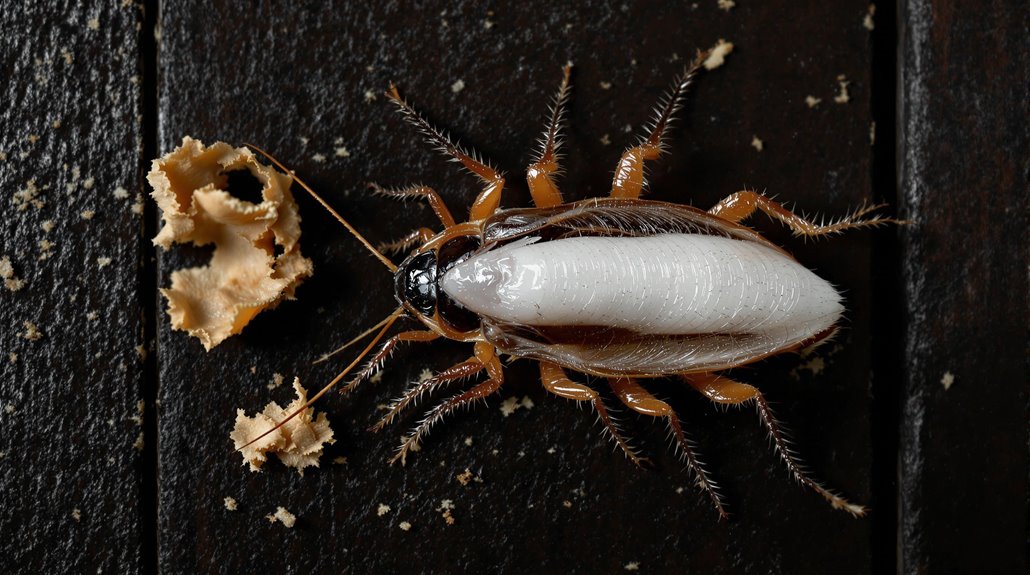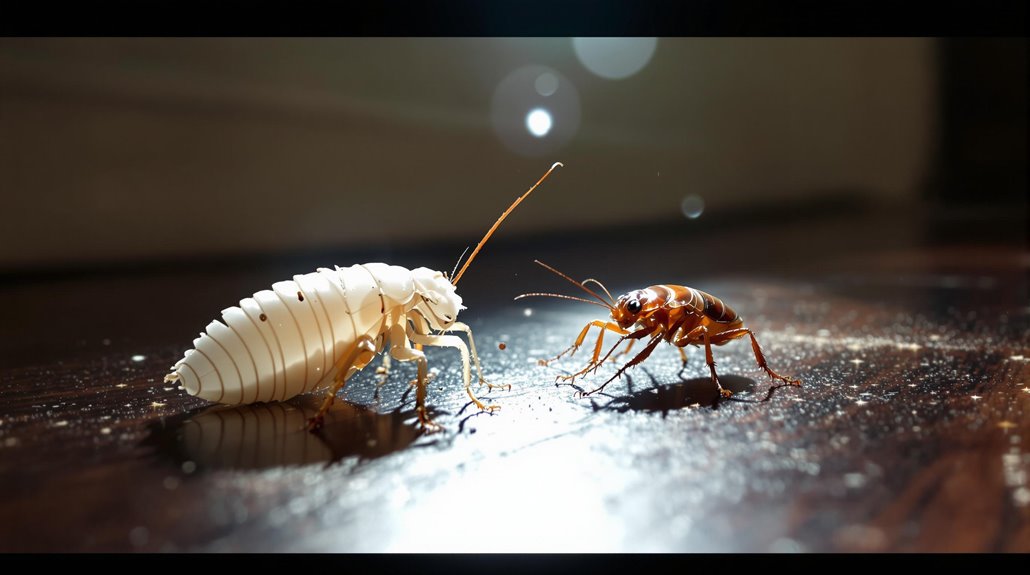When you spot a ghostly white cockroach, you’re witnessing a disturbing truth: active breeding behind your walls. These aren’t rare albino insects – they’re regular roaches in a vulnerable molting phase, shedding their old skin to grow larger. Multiple white sightings indicate an established colony that’s rapidly multiplying, with each female producing up to 300 offspring. Beyond the shock factor, these pests carry dangerous bacteria and allergens that threaten your family’s health. The full scope of this threat goes deeper than most homeowners realize.
What Makes a Cockroach Turn White?

When you spot a white cockroach in your home, you’re actually witnessing a fascinating but vulnerable phase of the insect’s life cycle known as molting.
During this process, the roach sheds its old exoskeleton to accommodate growth, temporarily exposing its soft, pale body underneath.
This transformation isn’t random cockroach behavior – it’s a precisely timed survival mechanism. Your unwanted houseguest will spend up to eight hours in this defenseless state while its new exoskeleton hardens and darkens through a process called sclerotization.
The insect coloration changes from ghostly white to its familiar brown shade as proteins in the shell oxidize.
Don’t let this vulnerable appearance fool you. These pests are most aggressive during molting, and their presence indicates an established infestation that’s actively growing in your walls.
The Molting Process Explained
When you spot a white cockroach in your home, you’re witnessing a vulnerable moment in the pest’s growth cycle known as molting.
During this process, the roach sheds its rigid outer shell, exposing a temporarily pale, soft exoskeleton that will gradually darken and harden over several hours.
The molting phase signals rapid growth in younger roaches, who must shed their shells up to eight times before reaching full maturity, leaving them defenseless and seeking dark hiding spots in your walls and cabinets.
Why Roaches Turn White
Despite what you might initially assume, those white roaches scurrying across your floor aren’t a unique species – they’re regular cockroaches going through a fascinating biological process called molting.
During this vulnerable phase of cockroach behavior, the insect’s exoskeleton splits open and sheds, exposing a soft, white body underneath. This newly formed exterior takes 2-8 hours to harden and develop its characteristic brown or black coloring.
It’s a critical process that allows these pests to grow.
Most pest control experts note that white roaches are actually more dangerous than their darker counterparts. Their fresh exoskeletons make them increasingly resilient to traditional pesticides, and they’re actively seeking food to fuel their transformation.
You’ll often spot them in areas with high moisture, particularly during nighttime hours when they’re most active.
Shedding Their Old Shell
The molting process begins with a cockroach’s internal pressure building to the breaking point. Their exoskeleton splits along the back, and you’ll witness them slowly emerging, pale white and vulnerable. This critical phase occurs multiple times during their lifecycle, with shedding frequency varying by species.
- Young roaches molt 6-8 times before reaching maturity
- The entire process takes 2-3 hours to complete
- New shells require 24-48 hours to fully harden
During molting, these pests are at their most defenseless state. Their shell durability is practically nonexistent, making them soft and ghostly white.
While you might think they’re easier to eliminate during this stage, they’re actually more likely to hide in your walls, waiting for their new armor to strengthen. This survival strategy explains why you’ll rarely encounter them in their white form.
Growth and Color Change
As newly molted cockroaches begin their transformation, you’ll notice a remarkable shift from ghostly white to amber-brown coloration.
During this vulnerable phase, white roach behavior becomes noticeably cautious as their exoskeleton hardens and darkens over 2-3 hours.
The process of cockroach coloration follows a precise timeline that pest control experts have documented extensively.
Within the first hour, their bodies start developing a light tan shade.
By hour two, you’ll observe their segments darkening to a medium brown.
The transformation culminates in that familiar, unsettling dark brown shell we’ve all come to recognize.
During this critical period, these pests seek dark, humid spaces – often deeper within your walls – where they can safely complete their metamorphosis without detection or disturbance.
Common Species That Display White Coloring
Several common cockroach species will appear stark white immediately after molting, including the notorious American and German varieties you’ll find in homes.
While genuine albino cockroaches exist due to genetic mutations, they’re extremely rare and account for less than 0.1% of documented cases.
If you’re spotting white roaches regularly, you’re likely witnessing the vulnerable post-molting phase when their new exoskeletons haven’t yet hardened and darkened, rather than encountering true albinism.
Newly Molted White Roaches
Common household cockroaches go through a fascinating yet disturbing transformation after molting, appearing ghostly white for up to eight hours.
During this vulnerable period, newly molted white cockroaches must hide from predators while their exoskeletons harden and darken. You’ll typically spot these alabaster specimens in dark, humid areas of your home where they feel protected.
- Their soft bodies are defenseless against both predators and pesticides
- The white coloring indicates the roach population is actively breeding
- Seeing one white cockroach means dozens more are likely hidden nearby
This stark white appearance serves as nature’s warning sign that your infestation is thriving.
The presence of these molting roaches confirms they’ve found ideal conditions to establish a growing colony within your walls.
Albino Cockroach Mutations
True albinism in cockroaches exists beyond temporary post-molting whiteness. You’ll find these rare genetic mutations occurring in about 1 in 100,000 specimens, showing complete absence of melanin throughout their lifecycle.
Unlike newly-molted roaches that darken within hours, these albino specimens maintain their pale appearance permanently.
The albino genetics in cockroaches follow similar patterns to other species’ mutations, affecting the production of body pigments.
While these adaptations might seem fascinating from a scientific perspective, they’re actually devastating to the insects’ survival. Without proper pigmentation, these cockroach adaptations leave them vulnerable to predators and UV damage.
They’re also less successful at finding mates, since their white coloring disrupts normal species recognition signals.
You’ll rarely encounter them in urban environments, as natural selection quickly eliminates these genetic variants from breeding populations.
Signs Your Home Has a Breeding Colony
Detecting a white cockroach breeding colony requires investigative diligence, as these elusive pests often hide their true numbers.
You’ll notice breeding signs through increased activity at night, particularly around moisture-rich areas of your home. The presence of egg casings and molted shells, especially near baseboards and cabinet corners, indicates an established colony that’s rapidly multiplying.
- Multiple white cockroach sightings within a 48-hour period suggest a breeding population has taken hold
- Distinct musty odors emanating from wall voids or under appliances indicate heavy infestation clues
- Finding both white and brown cockroaches together confirms an active breeding cycle is underway
Don’t dismiss these warning signals.
Once a colony establishes itself, their numbers can multiply exponentially within weeks, turning your home into their permanent breeding ground.
Health Risks Associated With White Roaches

While white cockroaches may appear less threatening than their darker counterparts, they pose equally severe health risks to your household. These pests carry harmful bacteria and allergens that can trigger serious respiratory issues and infections. You’ll find their presence creates significant sanitation concerns through contamination of food surfaces and storage areas.
| Health Hazard | Impact on Humans |
|---|---|
| Bacteria | Food poisoning |
| Allergens | Asthma attacks |
| Droppings | Skin rashes |
| Saliva | Respiratory issues |
| Shed skin | Allergic reactions |
Studies show that white roaches, typically in their molting phase, are actually more vulnerable to picking up pathogens due to their softer exoskeletons. They’re leaving a trail of contamination wherever they travel in your home, spreading disease-causing organisms across countertops, dishes, and food preparation areas.
Prevention Methods and Control Strategies
Protecting your home from white cockroach infestations demands a thorough defense strategy, given their documented health impacts.
The most effective prevention techniques combine structural maintenance with aggressive sanitation protocols, creating an inhospitable environment for these pests.
- Seal all entry points, including tiny cracks around pipes, windows, and doors using professional-grade caulk or expanding foam – they can squeeze through gaps as small as 1/16 inch.
- Maintain strict moisture control by fixing leaks immediately and using dehumidifiers in damp areas, as white roaches thrive in humid conditions.
- Implement strict food storage practices using airtight containers and guarantee thorough cleaning of surfaces, particularly in kitchens and bathrooms.
These control measures, when consistently applied, can reduce infestation risks by up to 90% according to pest management experts.
Best Treatment Options for Established Infestations
Once a white cockroach infestation takes hold, you’ll need a strategic combination of professional and DIY treatments to reclaim your space.
Start with targeted boric acid applications along baseboards and behind appliances, combined with natural repellents like diatomaceous earth and bay leaves in high-traffic areas.
Professional pest control services offer vital advantages through specialized equipment and commercial-grade insecticides. Their treatments penetrate deep into wall voids where white cockroaches often molt and reproduce.
You’ll want to schedule quarterly treatments for at least a year to break the breeding cycle completely.
Don’t fall for over-the-counter foggers – they’re ineffective against established colonies.
Instead, invest in gel baits containing hydramethylnon or fipronil, placing them strategically near water sources and dark corners where these pests congregate.
Understanding Cockroach Life Cycles

To effectively eliminate white cockroaches, you’ll need to understand their complex life cycle spanning four distinct stages. Environmental factors like temperature and humidity directly impact cockroach reproduction rates, with ideal conditions accelerating their population growth exponentially.
- Egg stage: Females produce up to 50 eggs per ootheca (egg case), with some species generating a new case every 30 days.
- Nymph stage: Young roaches molt 5-8 times before reaching maturity, appearing white immediately after each molt.
- Adult stage: Mature cockroaches can live 6-12 months, producing hundreds of offspring.
The rapid reproduction cycle means you’re not just dealing with the roaches you see. Behind your walls, generations of nymphs are developing simultaneously, creating an invisible army that’s preparing to emerge and infest your space.
When to Call Professional Pest Control
Many homeowners mistakenly delay professional intervention until their DIY efforts have failed completely. By then, white cockroaches may have established multiple breeding colonies throughout your home’s structure, making elimination exponentially more difficult and costly.
You should contact pest control immediately if you’ve spotted more than three white cockroaches within a week, discovered molted shells in dark spaces, or noticed an ammonia-like smell in your home.
These indicators suggest a severe infestation requiring professional help. Studies show that waiting just 30 days after initial sightings can lead to a 400% increase in cockroach populations.
Your pest management specialist will conduct a thorough inspection, identify entry points, and implement a targeted treatment plan that addresses both adult roaches and their offspring.
Conclusion
You’ve now glimpsed the unsettling world of white cockroaches, those ghostly harbingers of a larger infestation that could number in the thousands beneath your floorboards. While finding one molting roach might send shivers down your spine, you’re now equipped with the knowledge to take action. Don’t wait until these pale invaders multiply exponentially – implement prevention strategies today, and contact pest control if you spot these alabaster warnings in your home.





